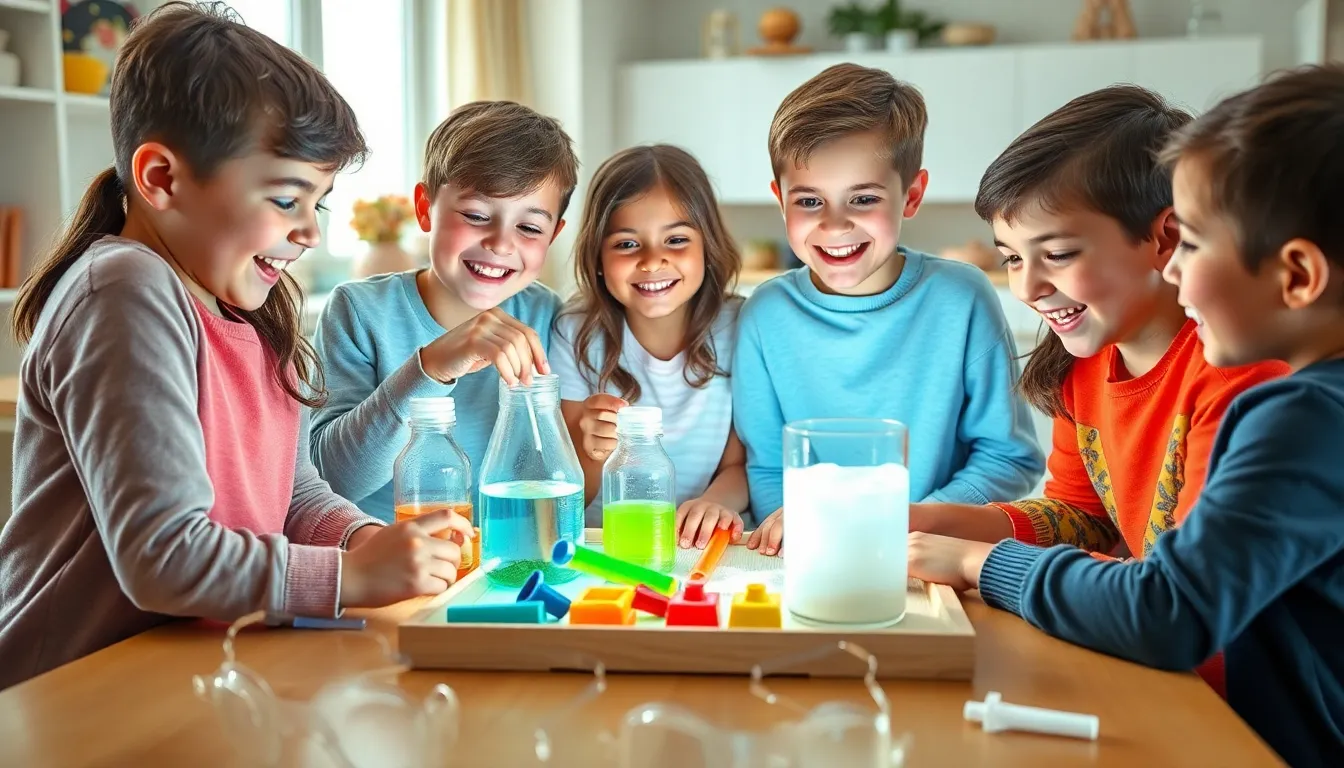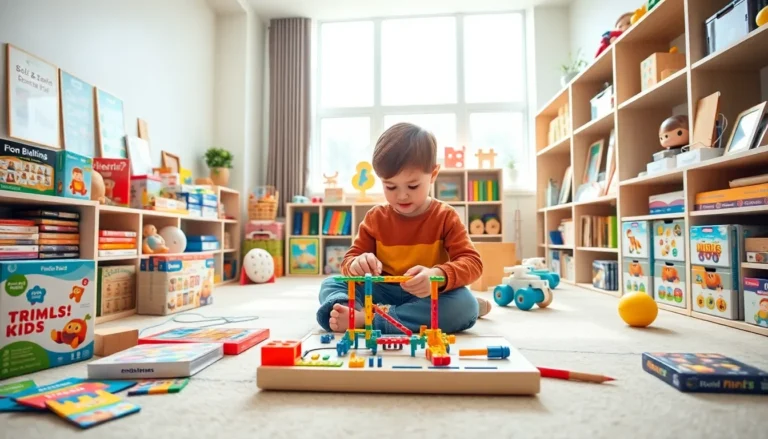Unlocking the wonders of science has never been easier—or more fun! Science kits for kids are like treasure chests filled with experiments that spark curiosity and ignite imaginations. From bubbling potions to explosive volcanoes, these kits transform young explorers into mini Einsteins, all while keeping parents blissfully entertained and slightly less worried about the mess.
Imagine your child donning a lab coat, armed with beakers and test tubes, ready to embark on a scientific adventure. With each kit, they not only learn about the world around them but also develop critical thinking skills and a love for discovery. Who knew that learning could feel like a magical quest? So buckle up; it’s time to dive into the exciting world of science kits that will have kids saying, “Eureka!” more often than ever.
Table of Contents
ToggleOverview of Science Kits for Kids
Science kits for kids provide a hands-on learning experience that captivates young minds. These kits include a variety of components, such as experiment materials, tools, and instructional guides, all designed to make scientific concepts accessible. Engaging projects encourage children to explore physics, chemistry, biology, and earth science through practical activities.
Educational benefits abound with science kits. They help develop critical thinking skills as children hypothesize, experiment, and draw conclusions. Problem-solving abilities strengthen when kids encounter challenges during experiments, prompting them to think creatively for solutions. By engaging in structured activities, children grasp foundational scientific principles while having fun.
Variety exists within science kits, catering to diverse interests. For instance, some kits focus on chemistry experiments, such as creating homemade slime or conducting simple reactions. Others may target physics enthusiasts, featuring projects like building rockets or simple circuits. Biological kits often include dissections or plant growth experiments, fostering a love for life sciences.
Many science kits target specific age groups, ensuring that the content is age-appropriate and engaging. Kids aged 5 to 10 often enjoy colorful, beginner-friendly kits, while those aged 11 and up may appreciate more complex projects that challenge their abilities. Parental involvement can also enhance the experience, guiding young scientists through challenging experiments and fostering collaborative learning.
Ultimately, science kits serve as valuable educational tools that spark curiosity and inspire a passion for discovery. They transform ordinary moments into extraordinary scientific adventures, making learning enjoyable and impactful.
Benefits of Science Kits for Kids

Science kits provide excellent educational opportunities while fostering children’s natural curiosity. Through hands-on experiments, kids learn scientific concepts in a fun and engaging manner.
Educational Value
These kits introduce various scientific principles through practical application. Children grasp challenging subjects like physics, chemistry, and biology while experimenting. Engaging instructions simplify complex ideas, making science accessible for all age groups. Kids conduct experiments that deepen their understanding of their surroundings. For example, mixing vinegar and baking soda illustrates chemical reactions.
Skills Development
Critical thinking receives a boost through science kit participation. Children hypothesize, test ideas, and analyze results, building essential problem-solving skills. Opportunities for collaboration arise when kids work together on projects. Hands-on activities enhance creativity, as children connect theoretical concepts to real-world applications. Kids develop perseverance when navigating challenges during experiments, preparing them for future academic endeavors.
Types of Science Kits for Kids
Science kits offer a diverse range of engaging subjects, allowing children to explore different scientific fields. Each type provides unique opportunities for hands-on learning and discovery.
Chemistry Kits
Chemistry kits encourage kids to investigate the world of chemical reactions. These kits often include safe, easy-to-use materials for experiments like creating colorful reactions with baking soda and vinegar. They help children understand fundamental concepts such as acids, bases, and polymers. Some kits even come with instructional booklets that guide young scientists through experiments, enhancing their learning experience. Safety features, such as goggles and gloves, help instill responsible laboratory practices. Chemistry kits inspire a passion for scientific inquiry while making learning interactive and enjoyable.
Biology Kits
Biology kits immerse children in the study of living organisms and ecosystems. Activities often include growing plants, observing microorganisms, and exploring human anatomy through models. Such experiences develop an appreciation for nature and life sciences. Children learn about concepts like cellular structure and photosynthesis in a hands-on way. Many biology kits feature real specimens or microscope slides, allowing for in-depth observation. By engaging with these kits, kids cultivate curiosity and become familiar with biological processes, enhancing their understanding of the natural world.
Engineering Kits
Engineering kits challenge children to design and build their projects using various materials and components. These kits frequently feature instructions for constructing bridges, robots, or simple machines, fostering creativity and innovation. Kids learn about principles such as force, tension, and energy transfer while problem-solving in practical scenarios. Many engineering kits encourage teamwork by providing collaborative projects. This interaction promotes communication skills and critical thinking as children work together to overcome challenges. Engineering kits not only spark interest in technology and engineering but also nurture essential skills for future learning.
Top Science Kits for Kids in 2023
In 2023, several science kits stand out for their innovative designs and educational value. These options captivate children while nurturing their love for science.
Kit Reviews
National Geographic Mega Crystal Growing Lab: This kit allows kids to create stunning crystals, teaching them about crystal formation. With easy-to-follow instructions, children enjoy a hands-on science experience.
Thames & Kosmos Chemistry C1000: This chemistry set introduces young scientists to essential chemical principles through engaging experiments. It includes over 125 activities that spark curiosity and foster exploration.
Snap Circuits Jr. Electronics Exploration Kit: This kit lets children build circuits easily without soldering. It promotes understanding of electrical concepts, enhancing their problem-solving skills through interactive play.
Scientific Explorer My First Mind Blowing Science Kit: Designed for younger kids, this kit features safe and simple experiments. It encourages exploration of fundamental science concepts while ensuring fun and engagement.
Great Explorations My First Science Kit: This introductory kit introduces basic scientific concepts through colorful, age-appropriate activities. Kids experiment with easy-to-use tools, fostering a hands-on learning experience.
Tips for Choosing the Right Science Kit
Consider the child’s age and interests when selecting a science kit. Younger children benefit from colorful, beginner-friendly kits that introduce basic concepts. In contrast, older kids often crave more complex projects that challenge their problem-solving abilities.
Evaluate the educational value of the kit. Science kits that include clear instructions and engaging experiments foster deeper understanding of scientific principles. Assess if the kit aligns with educational goals such as promoting creativity and critical thinking.
Examine the materials included in the kit. Quality components enhance the learning experience and ensure safety during experiments. Look for science kits with durable materials that can withstand repeated use.
Verify the kit’s versatility. Some kits provide multiple experiments or projects, allowing children to explore various topics in one package. Kits featuring themes like biology, chemistry, or engineering cater to specific interests, fostering broader educational experiences.
Check for reviews and recommendations. Kits that have received positive feedback from parents and educators often indicate quality and effectiveness. Browse educational websites or forums to gather insights from other users.
Engage in the selection process. Parental involvement enriches the experience, allowing guides to assist children throughout projects. Shared time spent on science kits reinforces bonds while sparking curiosity and enhancing learning.
Explore kit options from reputable brands. Manufacturers like National Geographic and Thames & Kosmos offer thoughtfully designed kits acclaimed for their educational value. Kits from established companies ensure reliability and depth in learning opportunities.
Science kits for kids are more than just fun activities; they’re gateways to a world of discovery. By engaging in hands-on experiments, children not only learn scientific principles but also develop critical skills that will serve them throughout their lives.
With a variety of options available, parents can find kits that align with their child’s interests and age, ensuring an enriching experience. The excitement of scientific exploration fosters a lifelong passion for learning and discovery. Investing in a quality science kit is a step toward nurturing the next generation of innovators and problem solvers.





